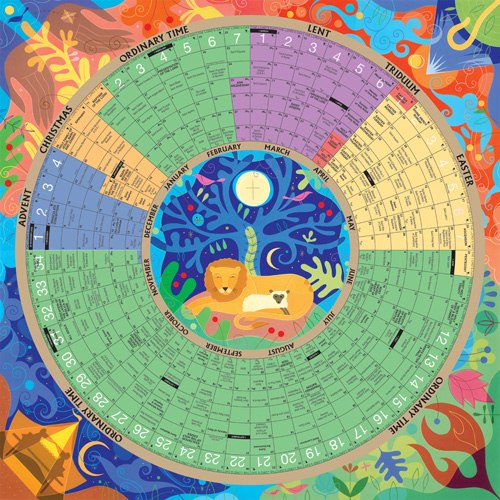The main point in the formation of the child is realizing that the child is geared by the graces of baptism to be formed.
Religion is not one more course among many. Although there is a discipline of the study of religion, the religious atmosphere should permeate home schooling.
If a parent is teaching music, the child can learn Marian hymns, even Latin hymns.
If a parent is teaching colour, as I showed in the photos in the last posts, the child can learn the liturgical year.
When I was home schooling, yearly, I bought the large circular liturgical year calendar. We followed the year in the house alongside the secular calendar.These are for sale on line.
To be a Catholic is a way of life, like saying grace before meals, stopping for the Angelus and so on.
Small church structures even made out of legos can include a lectern, altar, pulpit, confessional, baptismal font and so on. I did a history of architecture with my son when he was 4-5, walking around the village, learning the basics of medieval, Renaissance, and the subsequent forms and he also recognized those styles, such as Romanesque and Gothic in church architecture. I found post cards and photos from magazines for him to paste and write about in a little blue book.
None of this is expensive.
Instead of merely making lego scenes of pirates, one can act out the Crusades, or the English Civil War in specific battles for teaching. Look at this magnificent Seige of Zara from an online source. Fantastic.
Having an altar for Mary in May and October was a fun thing to do, as well as the usual Advent and Lenten children's activities.
In Advent, we made a little manger for a Christ Child and if my son was good, he could put in a piece of straw to make Baby Jesus's bed comfortable and, is he did something naughty, the straw would come out.
My mother did this with us. We enacted the night of the Nativity in the family, having costumes and props. and going from door to door in the house, with one of us standing behind saying no room at the inn and so on. Then baby Jesus was "born" and put into the hopefully snug straw filled manger, with quilt added.
We had a holy water font in the child's room, as I did as a child. And a crucifix in each room of the house, or an icon. We especially had fun on the feast of St. Nicholas, who always came secretly with candy, fruit and little toys. By the way, growing up in Iowa, with snow on the ground on the night of December 6th, we all looked for his footprints. He always came when the entire family was at supper, and it was not until I was in my forties that my mother told me that the Lutheran man next door would bring the things wearing his snowshoes so that there would be no prints. My mom brought stuff over to their house for years earlier in the day.
Of course, we have a magnificent Jesse tree wall hanging made by a non-religious woman who loved the boy and it was used all Advent, day by day. We used straight pins and said a prayer with each symbol, from a book I had bought in Minneapolis when I was about 25 and I have put these types of symbols on my blog in the past. I can do so again. If the children are old enough, they can draw these themselves. From there to Sherborne....(I wish I had my photos of these things, as I kept of record of most things). This photo from another family on line shows the same book symbol.
At the feast of January 6th, we had a house procession of the Three Kings with candles, as the Epiphany means Christ showing forth into the world. We also had made candles out of toilet paper rolls and cotton with the names of the Apostles on each one to remind the child that the Apostles brought the light of Christ to the nations.
These are just a few things we did, and more like making St Lucy Kat which you can find here
http://supertradmum-etheldredasplace.blogspot.ie/2012/12/st-lucy-kats.html
I shall write about Lenten practices tomorrow.





